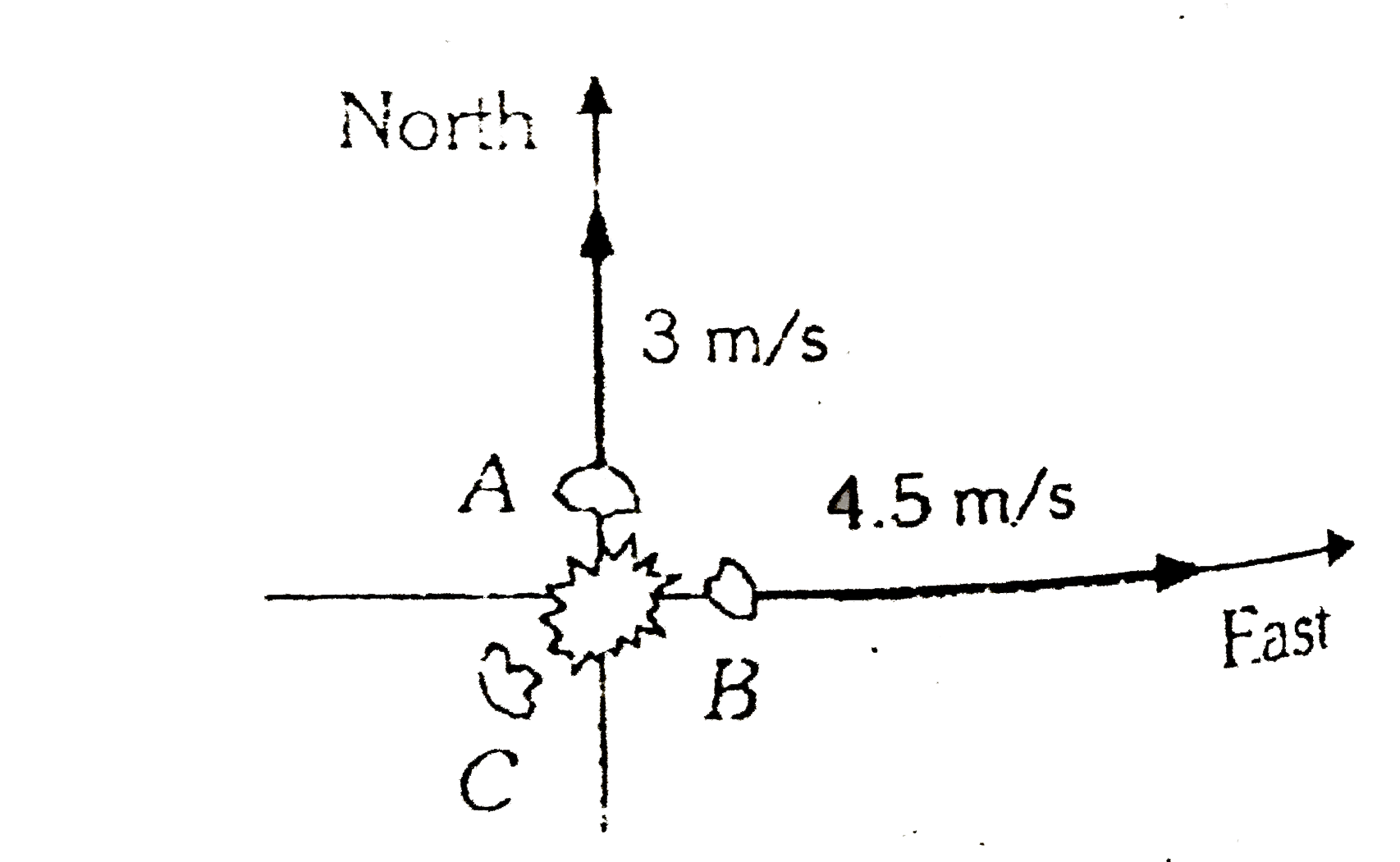A body is moving with velocity towards east. After its velocity becomes towards north. The average acceleration of the body is.
The correct Answer is:C
To find the average acceleration of the body, we can follow these steps:
Step 1: Identify Initial and Final Velocities
- The initial velocity →u is given as 30m/s towards the east. We can represent this in vector form as:
→u=30^im/s
- The final velocity →v is given as 40m/s towards the north. We can represent this in vector form as:
→v=40^jm/s
Step 2: Calculate Change in Velocity
- The change in velocity Δ→v is given by:
Δ→v=→v−→u
- Substituting the values:
Δ→v=(40^j−30^i)m/s=−30^i+40^jm/s
Step 3: Calculate Magnitude of Change in Velocity
- The magnitude of the change in velocity can be calculated using the Pythagorean theorem:
|Δ→v|=√(−30)2+(40)2
- Calculating:
|Δ→v|=√900+1600=√2500=50m/s
Step 4: Calculate Average Acceleration
- The average acceleration →a is given by the formula:
→a=Δ→vΔt
- Given that the time interval Δt=10s:
→a=50m/s10s=5m/s2
Final Result
- Therefore, the average acceleration of the body is:
→a=5m/s2
- The initial velocity →u is given as 30m/s towards the east. We can represent this in vector form as:
→u=30^im/s
- The final velocity →v is given as 40m/s towards the north. We can represent this in vector form as:
→v=40^jm/s
- The change in velocity Δ→v is given by:
Δ→v=→v−→u
- Substituting the values:
Δ→v=(40^j−30^i)m/s=−30^i+40^jm/s
- The magnitude of the change in velocity can be calculated using the Pythagorean theorem:
|Δ→v|=√(−30)2+(40)2
- Calculating:
|Δ→v|=√900+1600=√2500=50m/s
- The average acceleration →a is given by the formula:
→a=Δ→vΔt
- Given that the time interval Δt=10s:
→a=50m/s10s=5m/s2
- Therefore, the average acceleration of the body is:
→a=5m/s2
Topper's Solved these Questions
- BOOK - DC PANDEY ENGLISHCHAPTER - MOTION IN A PLANEEXERCISE - Check point 3.415videos
MOTION IN A PLANE
- BOOK - DC PANDEY ENGLISHCHAPTER - MOTION IN A PLANEEXERCISE - Check point 3.525videos
MOTION IN A PLANE
- BOOK - DC PANDEY ENGLISHCHAPTER - MOTION IN A PLANEEXERCISE - Check point 3.210videos
MOTION IN A PLANE
- BOOK - DC PANDEY ENGLISHCHAPTER - MOTIONEXERCISE - Medical entrances gallery19videos
MOTION
- BOOK - DC PANDEY ENGLISHCHAPTER - PROJECTILE MOTIONEXERCISE - Level - 2 Subjective10videos
PROJECTILE MOTION
Similar Questions
A particle is moing with a velocity of 10m/s towards east. After 10s its velocity changes to 10m/s towards north. Its average acceleration is:-
View SolutionA particle is moving eastwards with velocity of 5m/s. In 10sec the velocity changes to 5m/s northwards. The average acceleration in this time is.
View Solution
Knowledge Check
- Question 1 - Select One
A particle is moving at 5ms−1 towards east In one second its velocity changes to 5ms−1 towards north. Assuming the acceleration to be uniform, the change in velocity will be directed at
A135∘ to eastB135∘ to northC45∘ to eastD90∘ to east
A boy standing at the top of a tower of 20m. Height drops a stone. Assuming g=10ms−2 towards north. The average acceleration of the body is.
View SolutionA shell fired vertically up, when reaches its highest point, explodes into three fragments A,B and C of masses mA=4kg,ma=2kg and mc=3kg. Immediately after the explosion, A is observed moving with velocity vA=3m/s towards north and B with a velocity vb=4.5m/s towards east as shown in the figure. Find the velocity vc of the piece C.
 View Solution
View SolutionA body of mass 2kg moving with a velocity 3m/s collides with a body of mass 1kg moving with a velocity of 4m/s in opposite direction. If the collision is head on and completely inelastic, then
View SolutionA body of mass 5 kg is moving with velocity 2 ms−1. Calculate its linear momentum.
View SolutionA body of mass 5 kg is moving with velocity 2ms−1. Calculate its linear momentum.
View SolutionA body moving in a curved path possesses a velocity 3 m/s towards north at any instant of its motion .After 10s ,the velocity of the body was found to be 4 m/s towards west.Calculate the average acceleration during this interval.
View SolutionA body is moving with a velocity 5m/s along a striaght line.A force of 10N is applied to the body perpendicular to the line of motion. If the body is of mass 2kg, then the acceleration of the body along the initial straight line of motion is :
View Solution

